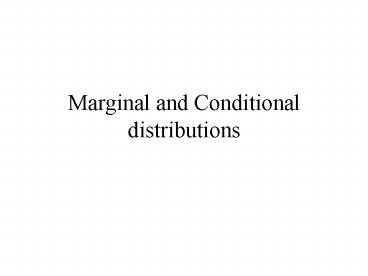Marginal and Conditional distributions PowerPoint PPT Presentation
1 / 53
Title: Marginal and Conditional distributions
1
Marginal and Conditional distributions
2
Theorem (Marginal distributions for the
Multivariate Normal distribution)
have p-variate Normal distribution
with mean vector
and Covariance matrix
Then the marginal distribution of is
qi-variate Normal distribution (q1 q, q2 p -
q)
with mean vector
and Covariance matrix
3
Theorem (Conditional distributions for the
Multivariate Normal distribution)
have p-variate Normal distribution
with mean vector
and Covariance matrix
Then the conditional distribution of given
is qi-variate Normal distribution
with mean vector
and Covariance matrix
4
is called the matrix of partial variances and
covariances.
is called the partial covariance (variance if i
j) between xi and xj given x1, , xq.
is called the partial correlation between xi and
xj given x1, , xq.
5
is called the matrix of regression coefficients
for predicting xq1, xq2, , xp from x1, , xq.
Mean vector of xq1, xq2, , xp given x1, ,
xqis
6
Example
Suppose that
Is 4-variate normal with
7
The marginal distribution of
is bivariate normal with
The marginal distribution of
is trivariate normal with
8
Find the conditional distribution of
given
Now
and
9
(No Transcript)
10
The matrix of regression coefficients for
predicting x3, x4 from x1, x2.
11
(No Transcript)
12
Thus the conditional distribution of
given
is bivariate Normal with mean vector
And partial covariance matrix
13
Using SPSS
Note The use of another statistical package such
as Minitab is similar to using SPSS
14
- The first step is to input the data.
The data is usually contained in some type of
file.
- Text files
- Excel files
- Other types of files
15
After starting the SSPS program the following
dialogue box appears
16
If you select Opening an existing file and press
OK the following dialogue box appears
17
Once you selected the file and its type
18
The following dialogue box appears
19
If the variable names are in the file ask it to
read the names. If you do not specify the Range
the program will identify the Range
Once you click OK, two windows will appear
20
A window containing the output
21
The other containing the data
22
To perform any statistical Analysis select the
Analyze menu
23
To compute correlations select Correlate then
BivariateTo compute partial correlations select
Correlate then Partial
24
for Bivariate correlation the following dialogue
appears
25
the output for Bivariate correlation
26
for partial correlation the following dialogue
appears
27
the output for partial correlation
- - - P A R T I A L C O R R E L A T I O N C
O E F F I C I E N T S - - - Controlling for..
AGE HT WT CHL
ALB CA UA CHL 1.0000
.1299 .2957 .2338 (
0) ( 178) ( 178) ( 178)
P . P .082 P .000 P .002 ALB
.1299 1.0000 .4778 .1226
( 178) ( 0) ( 178) ( 178)
P .082 P . P .000 P
.101 CA .2957 .4778 1.0000
.1737 ( 178) ( 178) (
0) ( 178) P .000 P .000
P . P .020 UA .2338
.1226 .1737 1.0000 ( 178)
( 178) ( 178) ( 0) P
.002 P .101 P .020 P . (Coefficient /
(D.F.) / 2-tailed Significance) " . " is printed
if a coefficient cannot be computed
28
Compare these with the bivariate correlation
29
Partial Correlations
CHL ALB CA
UA CHL 1.0000 .1299 .2957
.2338 ALB .1299 1.0000
.4778 .1226 CA .2957
.4778 1.0000 .1737 UA
.2338 .1226 .1737 1.0000
Bivariate Correlations
30
- In the last example the bivariate and partial
correlations were roughly in agreement. - This is not necessarily the case in all stuations
- An Example
- The following data was collected on the following
three variables
- Age
- Calcium Intake in diet (CAI)
- Bone Mass density (BMI)
31
The data
32
Bivariate correlations
33
Partial correlations
34
Scatter plot CAI vs BMI (r -0.447)
35
(No Transcript)
36
3D Plot
Age, CAI and BMI
37
(No Transcript)
38
(No Transcript)
39
(No Transcript)
40
Transformations
Theorem Let x1, x2,, xn denote random variables
with joint probability density function f(x1,
x2,, xn ) Let u1 h1(x1, x2,, xn).
u2 h2(x1, x2,, xn).
?
un hn(x1, x2,, xn).
define an invertible transformation from the xs
to the us
41
Then the joint probability density function of
u1, u2,, un is given by
where
Jacobian of the transformation
42
Example
Suppose that x1, x2 are independent with density
functions f1 (x1) and f2(x2) Find the
distribution of u1 x1 x2
u2 x1 - x2
Solving for x1 and x2 we get the inverse
transformation
43
The Jacobian of the transformation
44
The joint density of x1, x2 is f(x1, x2) f1
(x1) f2(x2) Hence the joint density of u1 and u2
is
45
Theorem Let x1, x2,, xn denote random variables
with joint probability density function f(x1,
x2,, xn ) Let u1 a11x1 a12x2 a1nxn c1
u2 a21x1 a22x2 a2nxn c2
?
un an1 x1 an2 x2 annxn cn
define an invertible linear transformation from
the xs to the us
46
Then the joint probability density function of
u1, u2,, un is given by
where
47
then
has a p-variate normal distribution
with mean vector
and covariance matrix
48
then
has a p-variate normal distribution
with mean vector
and covariance matrix
49
Proof
then
50
since
and
Also
and
hence
QED
51
Theorem Suppose that The random vector, has a
p-variate normal distribution with mean vector
and covariance matrix S
with mean vector
and covariance matrix
52
proof
Let B be a (p - q)? p matrix so that
is invertible.
then
is pvariate normal with mean vector
and covariance matrix
53
Thus the marginal distribution of
is qvariate normal with mean vector
and covariance matrix

